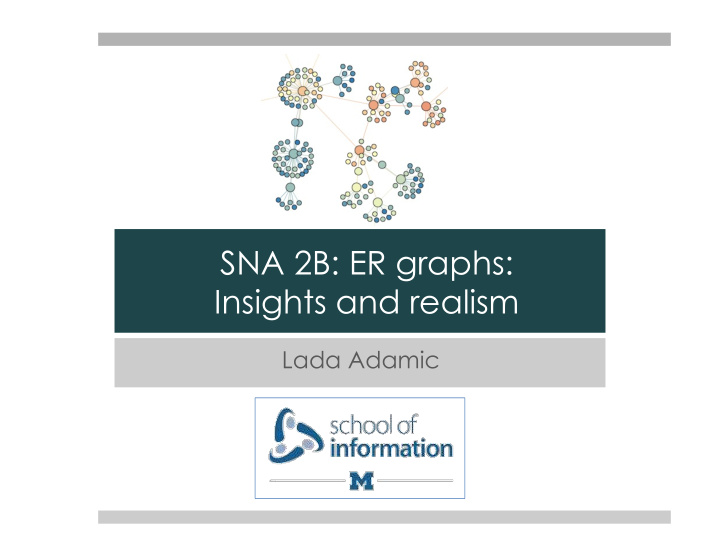



SNA 2B: ER graphs: Insights and realism Lada Adamic
Insights ¤ Previously: degree distribution / absence of hubs ¤ Emergence of giant component ¤ Average shortest path
Emergence of the giant component http://ccl.northwestern.edu/netlogo/models/GiantComponent
Quiz Q: ¤ What is the average degree z at which the giant component starts to emerge? ¤ 0 ¤ 1 ¤ 3/2 ¤ 3
Percolation on a 2D lattice http://www.ladamic.com/netlearn/NetLogo501/LatticePercolation.html
Quiz Q: ¤ What is the percolation threshold of a 2D lattice: fraction of sites that need to be occupied in order for a giant connected component to emerge? ¤ 0 ¤ ¼ ¤ 1/3 ¤ 1/2
Percolation threshold size of giant component Percolation threshold: how many edges need to be added before the giant component appears? As the average degree increases to z = 1, a giant component suddenly appears average degree av deg = 3.96 av deg = 0.99 av deg = 1.18
Giant component – another angle ¤ How many other friends besides you does each of your friends have? ¤ By property of degree distribution ¤ the average degree of your friends, you excluded, is z ¤ so at z = 1, each of your friends is expected to have another friend, who in turn have another friend, etc. ¤ the giant component emerges
Giant component illustrated
Why just one giant component? ¤ What if you had 2, how long could they be sustained as the network densifies? http://www.ladamic.com/netlearn/NetLogo501/ErdosRenyiTwoComponents.html
Quiz Q: ¤ If you have 2 large-components each occupying roughly 1/2 of the graph, how long does it typically take for the addition of random edges to join them into one giant component ¤ 1-4 edge additions ¤ 5-20 edge additions ¤ over 20 edge additions
Average shortest path ¤ How many hops on average between each pair of nodes? ¤ again, each of your friends has z = avg. degree friends besides you ¤ ignoring loops, the number of people you have at distance l is z l
Average shortest path
friends at distance l N l =z l scaling: average shortest path l av l av ~ log N log z
What this means in practice ¤ Erdös-Renyi networks can grow to be very large but nodes will be just a few hops apart 20 average shortest path 15 10 5 0 0 200000 400000 600000 800000 1000000 num nodes
Logarithmic axes ¤ powers of a number will be uniformly spaced 1 2 3 10 20 30 100 200 n 2 0 =1, 2 1 =2, 2 2 =4, 2 3 =8, 2 4 =16, 2 5 =32, 2 6 =64,….
Erdös-Renyi avg. shortest path 20 average shortest path 15 10 5 0 1 100 10000 1000000 num nodes
Quiz Q: ¤ If the size of an Erdös-Renyi network increases 100 fold (e.g. from 100 to 10,000 nodes), how will the average shortest path change ¤ it will be 100 times as long ¤ it will be 10 times as long ¤ it will be twice as long ¤ it will be the same ¤ it will be 1/2 as long
Realism ¤ Consider alternative mechanisms of constructing a network that are also fairly “random”. ¤ How do they stack up against Erdös- Renyi? ¤ http://www.ladamic.com/netlearn/nw/ RandomGraphs.html
Introduction model ¤ Prob-link is the p (probability of any two nodes sharing an edge) that we are used to ¤ But, with probability prob-intro the other node is selected among one of our friends’ friends and not completely at random
Introduction model
Quiz Q: ¤ Relative to ER, the introduction model has: ¤ more edges ¤ more closed triads ¤ longer average shortest path ¤ more uneven degree ¤ smaller giant component at low p
Static Geographical model ¤ Each node connects to num-neighbors of its closest neighbors ¤ use the num-neighbors slider, and for comparison, switch PROB-OR-NUM to ‘off’ to have the ER model aim for num- neighbors as well ¤ turn off the layout algorithm while this is running, you can apply it at the end
static geo
Quiz Q: ¤ Relative to ER, the static geographical model has : ¤ longer average shortest path ¤ shorter average shortest path ¤ narrower degree distribution ¤ broader degree distribution ¤ smaller giant component at a low number of neighbors ¤ larger giant component at a low number of neighbors
Random encounter ¤ People move around randomly and connect to people they bump into ¤ use the num-neighbors slider, and for comparison, switch PROB-OR-NUM to ‘off’ to have the ER model aim for num- neighbors as well ¤ turn off the layout algorithm while this is running (you can apply it at the end)
random encounters
Quiz Q: ¤ Relative to ER, the random encounters model has : ¤ more closed triads ¤ fewer closed triads ¤ smaller giant component at a low number of neighbors ¤ larger giant component at a low number of neighbors
Growth model ¤ Instead of starting out with a fixed number of nodes, nodes are added over time ¤ use the num-neighbors slider, and for comparison, switch PROB-OR-NUM to ‘off’ to have the ER model aim for num- neighbors as well
growth model
Quiz Q: ¤ Relative to ER, the growth model has : ¤ more hubs ¤ fewer hubs ¤ smaller giant component at a low number of neighbors ¤ larger giant component at a low number of neighbors
other models ¤ in some instances the ER model is plausible ¤ if dynamics are different, ER model may be a poor fit
Recommend
More recommend